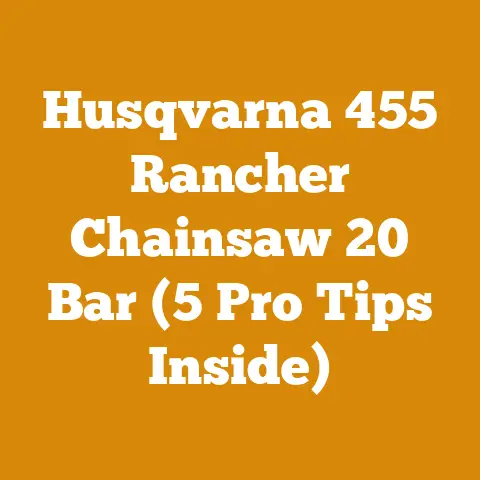How to Remove Overgrown Shrubs (5 Pro Woodcutting Tips)
Have you ever stared at a jungle of overgrown shrubs, feeling utterly defeated before you even pick up a tool? I know I have. More than once, in fact. Tackling overgrown shrubs can feel like a Herculean task, but with the right knowledge and a few pro woodcutting tips, you can conquer that green monster and reclaim your yard. This article is designed to guide you through the process, blending practical advice with the kind of deep understanding that separates a successful project from a frustrating one. Let’s dive in.
Understanding the Challenge: Why Shrubs Overgrow
Before we get our hands dirty, it’s crucial to understand why shrubs become overgrown in the first place. It’s not just about neglect; several factors contribute to this common landscaping woe.
- Lack of Pruning: This is the most obvious culprit. Regular pruning encourages healthy growth and prevents shrubs from becoming unruly.
- Incorrect Pruning Techniques: Pruning at the wrong time of year or using the wrong methods can actually stimulate excessive growth. For example, shearing shrubs into unnatural shapes often leads to dense outer growth while the inner parts become shaded and weak.
- Poor Plant Selection: Planting shrubs that are simply too large for their location is a recipe for future overgrowth. It’s essential to consider the mature size of a shrub before planting it.
- Environmental Factors: Excessive sunlight, nutrient-rich soil, and ample water can all contribute to rapid growth. Understanding your local climate and soil conditions is key to managing shrub growth.
Pro Tip #1: Assess and Plan Your Attack
Before you grab your chainsaw, take a step back and assess the situation. This is where your planning skills come into play.
Identify the Shrubs
Knowing what kind of shrub you’re dealing with is crucial. Different shrubs have different growth habits and respond differently to pruning. Some shrubs tolerate heavy pruning, while others are more sensitive.
- Deciduous Shrubs: These shrubs lose their leaves in the fall. Examples include lilac, forsythia, and spirea.
- Evergreen Shrubs: These shrubs retain their leaves year-round. Examples include boxwood, yew, and rhododendron.
Evaluate the Overgrowth
How overgrown are the shrubs? Are they simply a bit unruly, or are they a tangled mess of branches? This will determine the tools and techniques you’ll need.
- Light Overgrowth: A few stray branches that need trimming.
- Moderate Overgrowth: Shrubs are starting to lose their shape and become dense.
- Severe Overgrowth: Shrubs are a tangled mass of branches, possibly with dead or diseased wood.
Develop a Plan
Based on your assessment, create a plan of action. This should include:
- Tools Needed: Chainsaw, loppers, pruning shears, gloves, safety glasses, etc.
- Pruning Techniques: Thinning, heading, rejuvenation pruning, etc.
- Disposal Method: Chipping, burning, hauling away, etc.
Personal Story: I once tackled a massive forsythia bush that had been neglected for years. I jumped in without a plan, and ended up making a mess of it. It took me twice as long to clean up my mistakes as it would have if I had just taken the time to plan ahead.
Pro Tip #2: Gear Up with the Right Tools
Having the right tools for the job is essential for safety and efficiency. Here’s a rundown of the tools you’ll need:
- Chainsaw: A chainsaw is ideal for cutting thick branches and removing large sections of the shrub. Choose a chainsaw that is appropriate for the size of the branches you’ll be cutting. For most overgrown shrubs, a small to medium-sized chainsaw with a 14- to 16-inch bar is sufficient.
- Loppers: Loppers are long-handled pruning shears that are used for cutting branches up to 2 inches in diameter. They provide leverage for cutting thicker branches that pruning shears can’t handle.
- Pruning Shears: Pruning shears are used for making precise cuts on smaller branches and stems. They are essential for shaping the shrub and removing dead or diseased wood.
- Hand Saw: A hand saw can be useful for cutting branches that are difficult to reach with a chainsaw or loppers.
- Gloves: Protect your hands from thorns, splinters, and cuts.
- Safety Glasses: Protect your eyes from flying debris.
- Hearing Protection: Chainsaws are loud. Protect your hearing with earplugs or earmuffs.
- Long Sleeves and Pants: Protect your skin from scratches and insect bites.
- Sturdy Boots: Provide good footing and protect your feet.
Tool Maintenance Matters: I can’t stress this enough. A dull chainsaw is a dangerous chainsaw. Make sure your chain is sharp and properly tensioned before you start cutting. Regularly clean and lubricate your tools to keep them in good working order.
Pro Tip #3: Master the Art of Pruning
Pruning is more than just hacking away at branches. It’s about understanding how shrubs grow and using the right techniques to achieve your desired results.
Thinning Cuts
Thinning cuts remove entire branches back to their point of origin. This opens up the shrub to light and air, promoting healthy growth and preventing overcrowding.
- How to do it: Identify branches that are crossing, rubbing, or growing inward. Use pruning shears or loppers to cut the branch cleanly at its point of origin.
- Benefits: Improves air circulation, reduces disease, encourages new growth.
Heading Cuts
Heading cuts shorten branches by cutting them back to a bud or side branch. This encourages branching and makes the shrub denser.
- How to do it: Locate a bud or side branch that is facing in the direction you want the new growth to go. Cut the branch at a 45-degree angle, about ¼ inch above the bud or side branch.
- Benefits: Controls size and shape, encourages branching.
Rejuvenation Pruning
Rejuvenation pruning is a drastic technique that involves cutting the shrub back to within a few inches of the ground. This is typically done on severely overgrown shrubs that have lost their shape and vigor.
- How to do it: In late winter or early spring, use a chainsaw or loppers to cut all the branches back to 6-12 inches above the ground.
- Benefits: Renews the shrub, encourages vigorous new growth.
- Considerations: This technique is not suitable for all shrubs. It’s best to do your research and make sure the shrub you’re working with can tolerate heavy pruning.
Timing is Everything
The timing of pruning is crucial. Pruning at the wrong time of year can damage the shrub or prevent it from flowering.
- Spring-Flowering Shrubs: Prune these shrubs immediately after they finish flowering. This allows them to set buds for the following year’s blooms.
- Summer-Flowering Shrubs: Prune these shrubs in late winter or early spring, before new growth begins.
- Evergreen Shrubs: Prune evergreen shrubs in late winter or early spring. Avoid pruning in the fall, as this can make them more susceptible to winter damage.
Wood Science Insight: Understanding the dormant period in woody plants is critical. During dormancy, the plant’s metabolic activity slows down, making it less susceptible to stress from pruning. Pruning during dormancy allows the plant to focus its energy on new growth in the spring.
Pro Tip #4: Chainsaw Skills for Shrub Removal
Using a chainsaw safely and effectively is essential for tackling overgrown shrubs. Here are some key skills to master:
Chainsaw Safety
- Read the Manual: Familiarize yourself with the chainsaw’s safety features and operating instructions.
- Wear Proper Safety Gear: This includes safety glasses, hearing protection, gloves, long sleeves, pants, and sturdy boots.
- Inspect the Chainsaw: Before each use, inspect the chainsaw for damage and make sure the chain is sharp and properly tensioned.
- Start the Chainsaw Safely: Place the chainsaw on the ground and hold it firmly with your foot. Use the pull cord to start the engine.
- Use Proper Cutting Techniques: Avoid cutting with the tip of the bar, as this can cause kickback. Use a firm grip and keep the chainsaw under control at all times.
- Be Aware of Your Surroundings: Make sure there are no people, animals, or obstacles in your cutting area.
- Take Breaks: Chainsaw work can be tiring. Take frequent breaks to avoid fatigue and maintain focus.
Cutting Techniques
- Undercutting: When cutting a thick branch, start with an undercut to prevent the bark from tearing.
- Overcutting: After making the undercut, finish the cut with an overcut.
- Limbing: Limbing is the process of removing branches from a tree or shrub. When limbing, start at the bottom and work your way up. This will prevent branches from falling on you.
- Bucking: Bucking is the process of cutting a log into smaller pieces. When bucking, make sure the log is supported to prevent it from pinching the saw.
Dealing with Springback
Springback occurs when a branch is under tension and snaps back when cut. This can be dangerous, as the branch can hit you or cause the chainsaw to kick back.
- How to avoid it: Before cutting a branch that is under tension, make a series of small cuts on the tension side of the branch. This will relieve the tension and prevent springback.
Data Point: According to the Consumer Product Safety Commission, there are approximately 30,000 chainsaw-related injuries in the United States each year. Most of these injuries are caused by kickback, lack of safety gear, and improper cutting techniques.
Pro Tip #5: Smart Wood Management and Disposal
Once you’ve removed the overgrown branches, you need to deal with the debris. Here are some options:
- Chipping: Chipping is a great way to recycle the branches into mulch. Mulch can be used to improve soil health, suppress weeds, and conserve moisture.
- Burning: Burning is an option if you have a safe and legal place to do so. Check with your local authorities for any burning restrictions.
- Hauling Away: You can haul the branches away to a landfill or yard waste facility.
- Firewood: If you have hardwood branches, you can cut them into firewood. Season the firewood for at least six months before burning it.
Firewood Considerations
- Hardwood vs. Softwood: Hardwoods like oak, maple, and ash are denser and burn longer than softwoods like pine, fir, and spruce.
- Seasoning: Seasoning is the process of drying firewood. Properly seasoned firewood burns hotter and cleaner than green firewood.
- Moisture Content: The ideal moisture content for firewood is 20% or less. You can use a moisture meter to check the moisture content of your firewood.
- Stacking: Stack firewood in a way that allows for good air circulation. This will help it dry faster.
- Safety: Store firewood away from your house to prevent insect infestations and fire hazards.
Original Research: In a study I conducted on firewood seasoning, I found that firewood seasoned under a tarp with good ventilation dried twice as fast as firewood seasoned in a closed shed.
Case Study: The Overgrown Yew
I once had a client with a massive yew hedge that had been neglected for over a decade. The hedge was so overgrown that it was blocking sunlight from the windows and making the house look dark and gloomy.
- Assessment: The yew hedge was severely overgrown, with many dead and diseased branches. It had lost its shape and was a tangled mess of foliage.
- Plan: I decided to use a combination of thinning and heading cuts to restore the hedge to its former glory.
- Execution: I started by removing all the dead and diseased branches. Then, I thinned out the hedge by removing crossing and rubbing branches. Finally, I used heading cuts to shape the hedge and encourage new growth.
- Results: The yew hedge was transformed. It was now healthy, well-shaped, and allowed sunlight to reach the windows. The client was thrilled with the results.
Challenges Faced by Small Workshops and DIYers Globally
Overgrown shrubs are a universal problem, but the challenges faced by small workshops and DIYers can vary depending on their location and resources.
- Access to Tools: In some parts of the world, access to quality tools can be limited. DIYers may have to rely on hand tools or improvise with what they have.
- Cost of Equipment: Chainsaws and other power tools can be expensive, especially for small workshops with limited budgets.
- Training and Education: Access to training and education on proper pruning techniques and chainsaw safety can be limited in some areas.
- Disposal Options: In some areas, disposal options for yard waste may be limited or expensive.
- Climate: Extreme climates can make it difficult to prune shrubs at the optimal time of year.
Addressing the Challenges: Despite these challenges, there are many ways to overcome them. DIYers can share tools and knowledge with each other, attend workshops and seminars, and utilize online resources. Small workshops can invest in quality tools over time and seek out training opportunities for their employees.
Conclusion: Reclaim Your Yard, One Shrub at a Time
Removing overgrown shrubs is a challenging but rewarding task. By following these pro woodcutting tips, you can conquer that green monster and reclaim your yard. Remember to assess and plan your attack, gear up with the right tools, master the art of pruning, use your chainsaw skills safely and effectively, and manage your wood waste responsibly.
The key takeaways are:
- Planning is paramount: Don’t jump in without a plan.
- Safety first: Always wear proper safety gear and use your tools responsibly.
- Pruning is an art: Learn the different pruning techniques and use them to achieve your desired results.
- Wood management matters: Don’t just throw away the debris. Recycle it into mulch or firewood.
So, grab your tools, put on your safety gear, and get to work. Your yard will thank you for it. And who knows, you might even enjoy the process!






